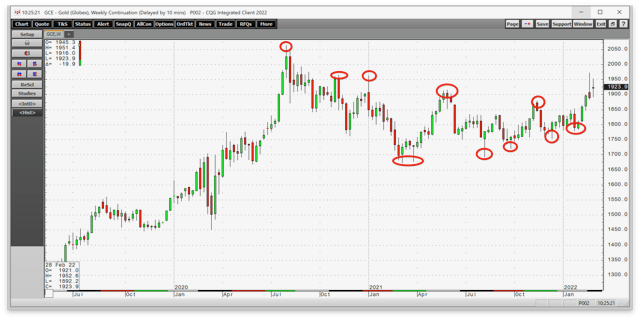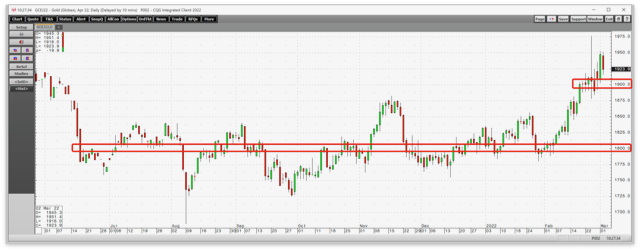Oil prices hold gains amid stalled Ukraine peace talks, US rate cut hopes
This post was written exclusively for Investing.com
- Gold Breaks Out Of Wedge Pattern
- First Commodity To Make New All-Time High In 2020
- Currency And Commodity: $1,900 Could Become New Pivot Point
- 3 Reasons Gold Is Heading Much Higher
- Many Ways To Invest In Gold
History often repeats. While the repetition is never perfect, future price action often mimics the past when the reasoning is similar.
In 2008, the global financial crisis caused central banks to flood the system with unprecedented liquidity. Government stimulus stabilized the economy, avoiding a recession, or worse. The liquidity and stimulus were successful tools, but they lit an inflationary fuse that took commodity prices to multi-year and, in some cases, all-time highs, by 2011-2012.
In 2011, gold rose to an all-time peak at $1,920.70 on the nearby COMEX futures contract as the yellow metal responded to inflation. Gold fell as the 2008 crisis began, but the price soared, reaching a peak three years later.
A dozen years down the road, in 2020, the global pandemic presented even more dire economic consequences as COVID-19 caused widespread sickness and death. The economic toll was devastating, and governments and central banks turned to the same tools and strategies developed in 2008. The only difference was the liquidity and stimulus levels were far higher starting in 2020.
Soon, after the 2008 stimulus and liquidity flooded the market, gold rose to new record highs, eclipsing the $1,000-per-ounce level. In August 2020, gold more than doubled that level when it reached $2,063 on the nearby COMEX futures contract. In 2021 and early 2022, as other commodity prices moved to new multi-year or all-time highs, gold corrected, consolidated, and digested the rally to the August 2020 peak. In February, economic and geopolitical factors began pushing gold higher, and the technical picture looks like a new record high could be on the horizon.
Gold Breaks Out Of Wedge Pattern
After reaching a record high in August 2020, gold consistently made lower highs through the week of Feb. 7, 2022.

Source: CQG
As the weekly chart highlights, the precious metal found a bottom in March 2021 and began making higher lows, forming a wedge pattern that tends to give way to a significant price move when it violates the latest higher low or lower high.
During the week of Feb. 14, gold broke above the first technical resistance level at the mid-November $1,879.50 high. On Feb. 24, as Russia invaded Ukraine, the nearby gold futures price reached the highest level since September 2020, when it traded to a high of $1,972.50 per ounce.
Gold broke out of the wedge pattern that had been in place over the past year to the upside. The price has been mostly above the $1,900-per-ounce level over the past week.
Gold Was First Commodity To Make New All-Time High In 2020
Gold was the leader of the commodity asset class in August 2020, becoming the first commodity to move to a new record high. The tidal wave of central bank liquidity and tsunami of government stimulus ignited an inflationary fuse, and gold was the first to respond.
Many other commodities, including copper, lumber, palladium and others, followed gold in 2021, reaching record highs, but gold corrected and consolidated around the $1,800 level, which became a pivot point. While other commodity prices reached multi-year or all-time peaks, gold digested its rally and moved into the wedge pattern that only gave way to the upside in February.
Currency And Commodity: $1,900 Could Become New Pivot Point
Gold is unique, it is a commodity, but it is also a currency. Governments validate gold’s role in the worldwide financial system as they hold the metal as an integral part of their foreign currency reserves. Over the past years, central banks and governments have been net buyers of the precious metal.
As the US and Europe slapped Russia with sanctions last week, the Russian ruble’s value precipitously dropped. As the Russian central bank scrambled to address sanctions, it resumed buying gold on the domestic market, starting Feb. 28. Russia is the world’s fifth-leading gold owner. In early 2022, Russia’s gold holdings were more than its US dollar holdings.
Russia and China have been building gold reserves buying domestic production over the past years. In 2021, Russia was the world’s third-leading gold producer behind China and Australia, with 310 tons or around 10 million ounces of annual production.

Source: CQG
The daily chart illustrates that after $1,800 was the pivot point for gold over the past year, $1,900 could develop into the level with magnetic powers after the break to the upside in February.
3 Reasons Gold Is Heading Much Higher
At least three factors increase the odds of a challenge of the August 2020 high after gold’s breakout to the upside:
- Inflation sits at the highest level in more than four decades, with the latest consumer price index at the 7.5% level and the producer price index at 9.7%. Inflation erodes fiat currency’s purchasing power. While central banks and governments can increase the money supply to their heart’s content, the only way to increase the gold supply is to extract more from the Earth’s crust. Gold has been an inflation barometer for centuries, if not thousands of years.
- Gold also tends to be a barometer of geopolitical tensions. The Russian invasion of Ukraine launched the first major war in Europe since World War II, with a nuclear power invading a sovereign country. While the US and NATO have not engaged and put boots on the ground in Ukraine, they support its sovereignty and have slapped Russia with unprecedented sanctions. Without a change in Russia’s government, tensions will likely remain high for the coming months and years after Russia moved to elevate its nuclear readiness last weekend.
- China, the world’s most populous country and second-leading economy, forged an alliance with the Russian government, which could make sanctions toothless. Moreover, Russia’s invasion of Ukraine could encourage China to accelerate its plans to reunify with Taiwan. Moreover, the deteriorating geopolitical landscape put Russia, China, North Korea, and Iran on one side, with the US, Europe, Japan, Canada, Australia, and other allied countries on the other. As the world emerges from the global pandemic, hostilities are now the risk that humanity is facing. As China and Russia look to move away from the US dollar, the current world’s reserve currency, the move will weigh on the US dollar’s value versus gold, the ultimate currency.
Markets reflect the economic and political landscapes. The case for higher gold prices is compelling in the current environment.
Many Ways To Invest Gold
The most direct route for investing in gold is via the bars and coins offered by worldwide physical dealers. Owning the physical metal guarantees 100% exposure to the gold price. Derivative products provide exposure, but they carry risks if gold deviates from the derivatives. Some of the choices are:
- ETF and ETN products that hold gold tend to track the price. The SPDR® Gold Shares ETF (NYSE:GLD) product is the most liquid gold ETF. The iShares Gold Trust (NYSE:IAU) and GraniteShares Gold Trust ETN (NYSE:BAR) products also offer exposure to gold, as they hold physical metal.
- Gold mining stocks tend to outperform gold when it rallies and underperforms when the metal’s price declines. Gold mining stocks are leveraged as companies invest capital in mines that yield metal, but they carry idiosyncratic risks, including management decisions and specific mining properties. In a world where geopolitical risk is at the highest level in decades, the potential for the nationalization of mining properties could increase. While China is the world’s leading gold mining country, Newmont Goldcorp (NYSE:NEM) and Barrick Gold (NYSE:GOLD) are North America’s leading gold-producing companies with global mining interests.
- The VanEck Gold Miners ETF (NYSE:GDX) and VanEck Vectors Junior Gold Miners ETF (NYSE:GDXJ) products hold portfolios of the leading gold mining and junior gold mining companies, respectively. While they diversify the risk of owning single mining companies, they are not gold but gold mining investments.
While the geopolitical and economic landscapes support higher gold prices, the US central bank will tighten monetary policy, causing interest rates to rise, lifting the cost of holding the metal. Gold competes with other assets for investment capital.
While gold is a commodity with industrial uses, the market’s sentiment and investment demand drive gold’s price higher or lower. Rising US rates should support the US dollar, which is typically not bullish for gold. However, the current geopolitical landscape is anything but ordinary, and gold is likely to head for a new record high.
We could see the price settle into a higher trading range around the $1,900 level. However, that would likely set the stage for a challenge of the August 2020 high of $2,063 and could propel gold far higher as inflationary pressures continue to increase as tit-for-tat sanctions and retaliatory measures with the Russians may only be starting.
